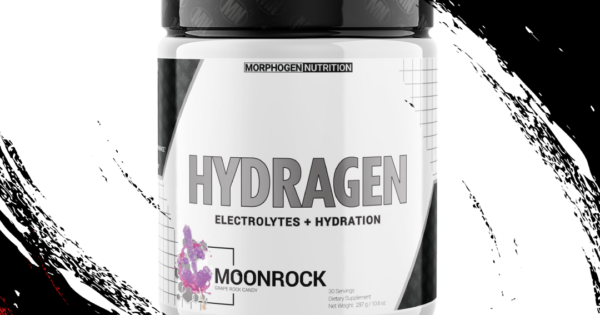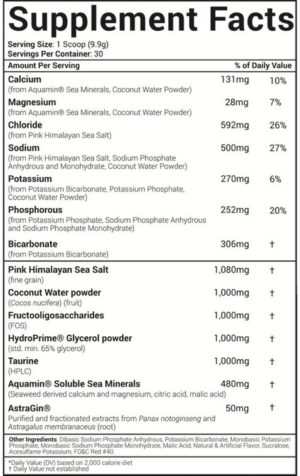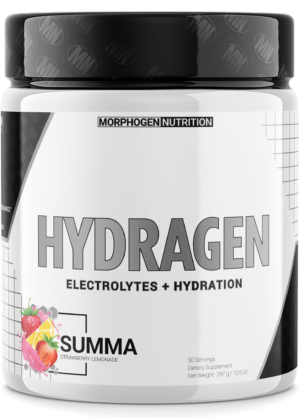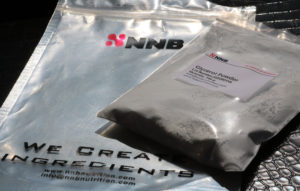Peak Hydration Built for Athletes
Pink Himalayan Sea Salt – 1,080 mg
Given all the negative press about sodium in recent decades, some may be surprised to see a whole gram of salt headlining a hydration formula. But not Morphogen fans, who are used to their favorite brand doing it right.
But as we’ll demonstrate, a hefty serving of pink Himalayan salt can actually be a huge boon for your hydration status and overall health. In fact, the most serious supplement companies, marketing to the most serious users and athletes, are increasingly using lots of salt in this application as well as in their pre-workouts.
Not all the sodium inside is coming from pink Himalayan salt – there’s some in coconut water – but most of it is.
Sodium in HYDRAGEN: 500 milligram yield
However you break down the source of it, the label for HYDRAGEN tells us you’re getting 500 milligrams of pure sodium per serving. That’s remarkable – it’s about five times what we usually see in hydration supplements.
Again, this is great – doses in the 100-milligram to 200-milligram arena simply aren’t going to move the electrolyte-replenishment needle for consumers most in need of special hydration support.
However, the first thing we should say is that although we’ll be taking a generally pro-sodium stance in this article, it is possible to get too much (and your body will generally tell you that just by the mere taste of salt). So, you should always consider sodium supplementation in the context of your entire diet, and add up all your sources of sodium to determine whether your total intake is within the acceptable range.
The second point to make about this hefty dose of sodium is that sodium isn’t the only electrolyte mineral in HYDRAGEN – calcium, magnesium, and potassium are also well represented, and will help round out the effects of the sodium. But Morphogen went big on sodium here, and so are we:
A sodium primer
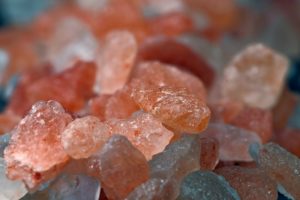
Himalayan pink salt is an excellent source of electrolytes. Don’t fear the sodium!! We need it for optimal training!
With those caveats out of the way, let’s talk about the main reasons we’re excited about 500 milligrams of sodium yield in HYDRAGEN.
First is that sodium is the primary electrolyte lost in sweat. We lose approximately 0.9 grams of sodium per liter of sweat, with the next biggest loss being potassium at only 0.2 grams per liter.[1]
In other words, we lose four times as much sodium in sweat as potassium,[1] and we lose even less of the other minerals. If you’re sweating, you’re sweating mostly sodium — this is why sweat is salty!
This matters because if you’re concerned about hydration enough to reach for a hydration supplement, you’re probably sweating a lot. Any kind of hard physical activity like exercise, manual labor, or even just being outside on a hot day will cause you to lose lots of sodium that needs to be replenished for optimal health.
If you fail to replace this lost sodium, you might even end up sodium deficient. That’s potentially a big problem, since sodium is needed for muscular contractions.[2] Muscles that don’t get enough sodium from your blood can function below their full potential.[3]
In severe cases, sodium deficiency caused by dehydration, known officially as hyponatremia, can be a life-threatening condition.[4]
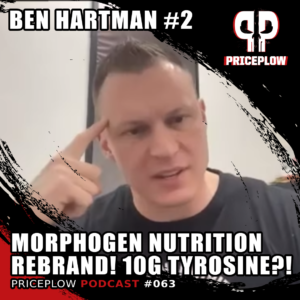
Ben Hartman returns to talk about Morphogen Nutrition’s rebrand, some new formulas, and more on his backstory. Watch it in Episode #063 of the PricePlow Podcast!
The question of how much sodium a physically active person requires is a whole discussion unto itself. If you’re interested in learning more about this, you should check out our favorite reference article on the subject, The Importance of Salt in the Athlete’s Diet.[3]
A major pointe the researchers make is that fluid replacement with incomplete solutions can lead to complications like the aforementioned hyponatremia, decreased performance, heat cramps, and other heat-related illnesses and conditions. If you train hard, if you sweat… you need a lot of this electrolyte.
How much sodium is really too much?
So now that we’ve touched on the consequences of not getting enough sodium, let’s talk about what happens when you get too much – and more importantly, how much is too much. As with many other subjects in nutritional science, long-standing conventional beliefs on this subject have been challenged by recent research.
Although Americans have officially been advised to consume less than 2,300 milligrams of sodium per day, there’s an argument to be made that we might actually need more sodium than that for optimal health.
The funny thing is that the negative consequences of getting too little sodium are actually quite similar to those of getting too much. As Thomas Remer points out in his article, “High salt intake: detrimental not only for blood pressure, but also for bone health”:
“[C]urrent evidence from prospective cohort studies suggests a J-shaped association between sodium intake and cardiovascular events, based on studies from >300 000 people, and suggests that the lowest risk of cardiovascular events and death occurs in populations consuming an average sodium intake range (3-5 g/d). The increased risk of cardiovascular events associated with higher sodium intake (>5 g/d) is most prominent in those with hypertension.”[5]
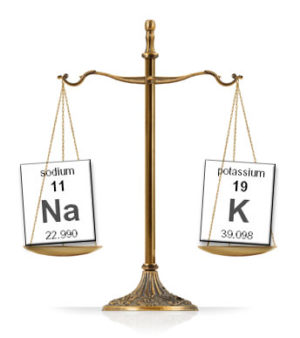
It’s all about the potassium sodium BALANCE. Too many supplements are too heavy on sodium without adding potassium.
According to this data, the adverse health effects of sodium consumption statistically don’t even begin until you’re consuming more than 5,000 milligrams daily! Even the low end of the safe range, 3,000 milligrams of sodium per day, is still more than the old 2,300 recommended maximum.
Put simply, the government’s guidelines don’t match up with the science.
And what’s more, limiting your sodium intake too much might increase your risk of cardiovascular problems!
A big 2011 study published in the Journal of American Medicine that included over 28,000 participants concluded that urinary sodium intake of less than 3,000 milligrams per day actually increased subjects’ risk of being hospitalized for congestive heart failure.[6]
According to this study, consuming up to 7,000 milligrams of sodium per day did not, on average, increase subjects’ risk of cardiovascular disease![7]
A meta-analysis from 2011 reviewed data from seven different studies and found that salt restriction actually increased overall mortality in patients with existing heart disease.[8]
So are we saying that you, the reader, should necessarily start eating a ton of salt? Not necessarily just yet, but there’s a good chance that most athletes — especially those who sweat — aren’t coming close to these numbers. Everything in health and nutrition is individualized, so you should always track your nutritional intake, gauge how you feel, and talk to your doctor before making a major dietary change.
Point is, for most athletes, going bigger on this mineral with a dose like 500 milligrams in HYDRAGEN, is likely far more beneficial than you realize.
Lots of physicians have acknowledged that the individual response to sodium can vary considerably. All the way back in the dark ages of 1987, many doctors had noticed that for any given patient, eating more sodium was about as likely to decrease their blood pressure as it was to increase it.[9] And what’s more, most people saw no change in blood pressure at all.
Still, though, other research has shown that patients who get randomized to a low-sodium diet have a 25% lower risk of heart attack or stroke compared to a placebo sham intervention.[10]
It really just depends on you, but if you know you’re sweating a lot, HYDRAGEN may be the hydration supplement you’ve been looking for. Now let’s balance that sodium out with some potassium:
HydroPrime Glycerol powder (std. min. 65% glycerol) – 1,000 mg
HydroPrime is a trademarked form of glycerol from NNB Nutrition.
Glycerol is an osmolyte, meaning that it can boost cellular hydration by increasing osmotic pressure around your cells, which naturally forces a higher than normal amount of water into your cells.
Increased cellular water content protects cells from heat stress and improves stores of nutrients available to your cells. This can actually cause an ergogenic – performance-enhancing – effect, thanks to the resulting improvement in cellular function.[25]
Glycerol is also known to give users a wicked pump, which athletes and bodybuilders are going to love.[26]
Keep your hydration
Additionally, an extra unique benefit to glycerol is that it reduces urine output, as shown in numerous studies we’ve discussed in the past.[27] Nobody wants to lose even more fluids, having to go to the restroom too often when training. Glycerol may help retain some of that for a bit longer, keeping your rest stops at a mininum.
The issue with generic glycerol is that it has an unfortunate tendency to clump during long-term storage. When glycerol, mixed with other ingredients, clumps up, it can render the entire supplement unusable – an outcome referred to as “bricking.”
Because of this, glycerol was falling out of favor with supplement formulators. But that’s when HydroPrime came along!
Because of NNB’s new method for stabilizing and powderizing glycerol, they were able to create a form of glycerol that doesn’t clump nearly as much as the generic stuff, and, hence, is much more shelf stable.
Given that HydroPrime’s effectiveness is intricately related to its effect on hydration, it probably won’t surprise you that it’s most effective when taken with plenty of water.
Taurine (HPLC) – 1,000 mg
Taurine is also an osmolyte, with the same cellular hydration benefits as HydroPrime.[29]
A 2018 meta-analysis on taurine found that even a single 1,000-milligram dose – note, the same dose used in Morphogen Hydragen – is enough to immediately boost athletic endurance during a workout.[30]
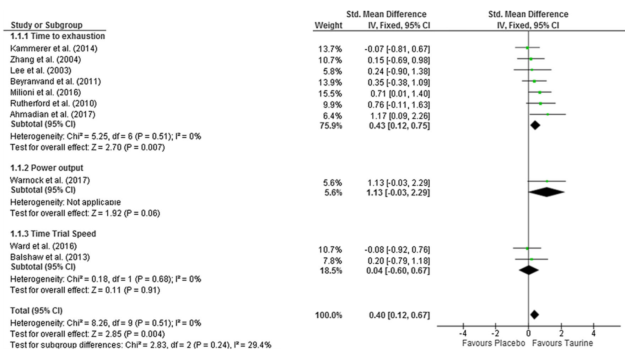
Taurine, long used for a ‘filler’ amino acid, turns out to be legit for endurance… and after a single use![30]
Taurine is also a potent antioxidant, and can help support calcium signaling between muscle cells, which can help support muscular contractions. It can also improve cognition.
Supplementing taurine is a wise move for anyone who’s exerting themselves to the utmost, since taurine is a conditionally essential amino acid.[29-31] This means that whenever you go through something metabolically stressful – whether it be injury, illness or just a demanding physical training regimen – your body’s requirements for taurine can increase.
In these cases, supplementation with conditionally essential amino acids like taurine is not a bad idea.
Taurine also has some pretty cool nootropic effects. Thanks to its GABAergic function in your central nervous system, it can help take the edge off stimulants like caffeine, much like L-theanine.
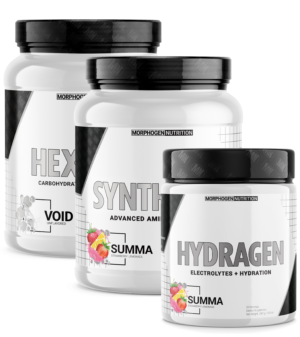
Morphogen Nutrition’s Intra Workout Stack brings a total of 3 grams of taurine and tons of other amino acids and electrolytes
Taurine is GABAergic, helping decrease neural inflammation while facilitating inter-synaptic communication and improving mitochondrial function in your neurons.[31]
In other words, taurine is good for both mental and physical performance, making its inclusion in hydration formulas a no-brainer.
Go bigger with Synthegen
If you want to look into even greater doses of taurine (which brings even more clinically-studied benefits), consider stacking HydraGen with SYNTHEGEN, Morphogen’s advanced amino acid matrix. It provides another 2 grams of taurine, and has similar flavor systems for intra workout stacking!

